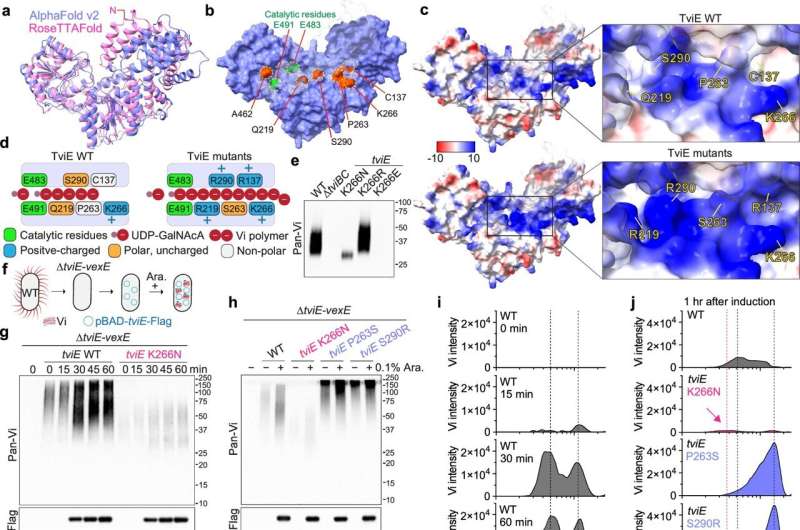This article has been reviewed according to Science X's editorial process and policies. Editors have highlighted the following attributes while ensuring the content's credibility:
fact-checked
peer-reviewed publication
trusted source
proofread
Diversity in typhoid bacteria linked to higher mortality rates

Worldwide, 20% of the bacterial strains that cause typhoid fever have genetic variations in their external layer, called Vi capsule, that provide higher virulence, higher infectivity and high antibiotic resistance, Cornell researchers have discovered, possibly impacting the disease's propagation and vaccine efficacy.
The study, published June 19 in Nature Communications, marks the first time these variants of Salmonella Typhi (S. Typhi) have been described by science.
"By combining epidemiology, genomics and molecular investigation, we were able to provide much-needed insights into the various types and consequences of the Vi capsule variants of S. Typhi," said Jeongmin Song, associate professor in the Department of Microbiology and Immunology in the College of Veterinary Medicine, who led the study.
Gi Young Lee, a postdoctoral researcher in Song's lab, co-authored the paper.
S. Typhi is transmitted through contaminated food and water, and causes 200,000 deaths per year. To thrive in a host, S. Typhi relies on a structure called the Vi capsule, a layer that covers the exterior of the bacteria and serves as a protective cloak against the host's immune system. The molecules that form the Vi capsule, called capsular polysaccharides (CPS), are used to create typhoid vaccines.
Despite the importance of the Vi capsule, its genetic diversity and how it may affect virulence had not been documented until now. "Before, we thought there was only one type," Song said. "We were curious to know whether there are Vi capsule variations among S. Typhi clinical strains found at various times and locations."
To investigate the potential variability in Vi capsules, Lee and Song analyzed the whole genome of 5,379 strains collected worldwide. Two particular enzymes involved in Vi capsule synthesis carried a lot of genetic variation.
Focusing on 21 of the most common mutations found in these enzymes, Lee and Song established how this genetic variation affected the composition of the CPS forming the Vi capsule. "We made an intriguing finding," Song said. "Each of these specific point mutations leads to a distinct variant form of Vi."
Based on these structural properties, Lee and Song categorized S. Typhi variants into two main groups, hypo and hyper Vi capsule variants, referring to the amount, length or chemical properties of the CPS.
Compared to the only known type of Vi capsules, S. Typhi with hypo Vi capsules have a higher ability to infect a host. S. Typhi with hyper Vi capsules, in turn, make infected mice sicker and have a higher mortality rate.
In addition, bacteria with hyper Vi capsules have an enhanced ability to colonize the gallbladder. Importantly, between 2% to 6% of recovered patients with S. Typhi in the gallbladder become asymptomatic chronic carriers, and can shed S. Typhi for months or years, contributing to the persistence of the disease. "It's like the story of Typhoid Mary," Song said.
Also concerning is Lee and Song's finding that hyper Vi strains are more geographically distributed than hypo Vi and show more antibiotic resistance. "It is alarming that all instances of a specific hyper Vi capsule variant have demonstrated resistance to ciprofloxacin, a commonly used treatment for typhoid patients in clinical settings," Song said.
Song's discovery has broad implications for epidemiology. For example, Song said it might be beneficial to update current detection methods to identify the circulating variants. Her findings also open possible clinical applications. We don't know, she said, if the typhoid vaccine is equally effective against all types of Vi capsules.
As a next step, Song is expanding the correlation between genetic variation and capsule properties beyond the 21 described in her paper to all variants discovered. "We want to produce a reference chart for the scientific community," she said. She is also working on other species of Salmonella that produce capsules similar to the hyper type, including the Salmonella Paratyphi C, which causes a disease similar to typhoid and Salmonella Dublin, that can infect humans and cattle.
"Overall, our study raises awareness of the existence of many Vi capsule types of S. Typhi, both within and outside the scientific community," Song said. "It is a framework for future research on S. Typhi capsule variants and it provides strategies to combat [these types of] bacteria."
More information: Gi Young Lee et al, Single missense mutations in Vi capsule synthesis genes confer hypervirulence to Salmonella Typhi, Nature Communications (2024). DOI: 10.1038/s41467-024-49590-6
Journal information: Nature Communications
Provided by Cornell University




















